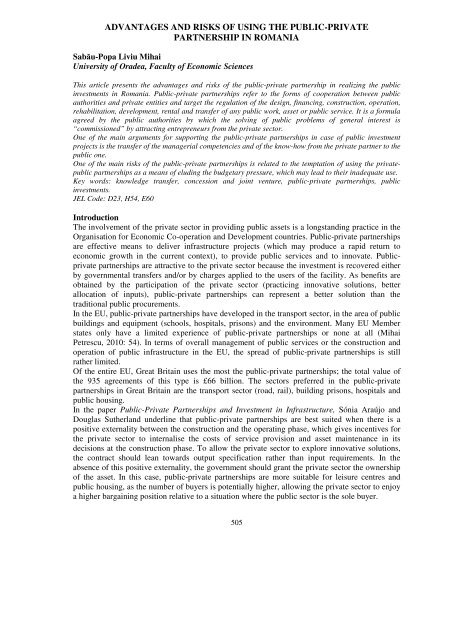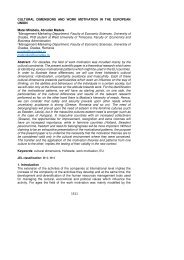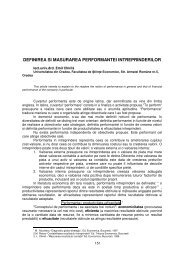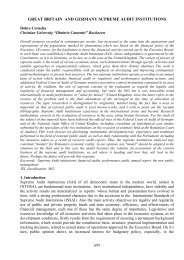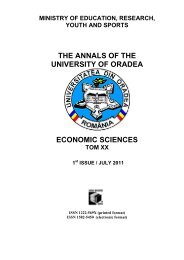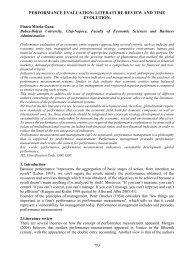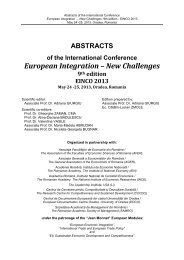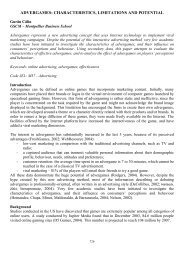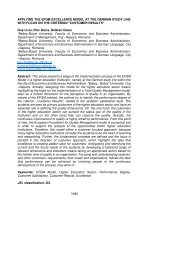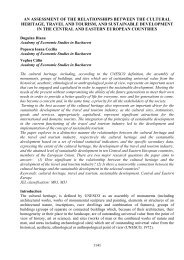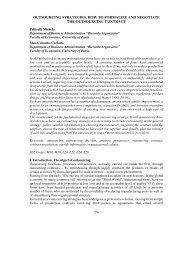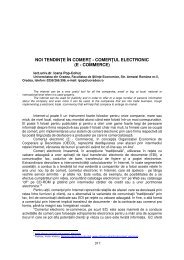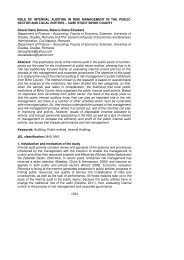advantages and risks of using the public-private partnership in ...
advantages and risks of using the public-private partnership in ...
advantages and risks of using the public-private partnership in ...
Create successful ePaper yourself
Turn your PDF publications into a flip-book with our unique Google optimized e-Paper software.
ADVANTAGES AND RISKS OF USING THE PUBLIC-PRIVATEPARTNERSHIP IN ROMANIASabu-Popa Liviu MihaiUniversity <strong>of</strong> Oradea, Faculty <strong>of</strong> Economic SciencesThis article presents <strong>the</strong> <strong>advantages</strong> <strong>and</strong> <strong>risks</strong> <strong>of</strong> <strong>the</strong> <strong>public</strong>-<strong>private</strong> <strong>partnership</strong> <strong>in</strong> realiz<strong>in</strong>g <strong>the</strong> <strong>public</strong><strong>in</strong>vestments <strong>in</strong> Romania. Public-<strong>private</strong> <strong>partnership</strong>s refer to <strong>the</strong> forms <strong>of</strong> cooperation between <strong>public</strong>authorities <strong>and</strong> <strong>private</strong> entities <strong>and</strong> target <strong>the</strong> regulation <strong>of</strong> <strong>the</strong> design, f<strong>in</strong>anc<strong>in</strong>g, construction, operation,rehabilitation, development, rental <strong>and</strong> transfer <strong>of</strong> any <strong>public</strong> work, asset or <strong>public</strong> service. It is a formulaagreed by <strong>the</strong> <strong>public</strong> authorities by which <strong>the</strong> solv<strong>in</strong>g <strong>of</strong> <strong>public</strong> problems <strong>of</strong> general <strong>in</strong>terest is“commissioned” by attract<strong>in</strong>g entrepreneurs from <strong>the</strong> <strong>private</strong> sector.One <strong>of</strong> <strong>the</strong> ma<strong>in</strong> arguments for support<strong>in</strong>g <strong>the</strong> <strong>public</strong>-<strong>private</strong> <strong>partnership</strong>s <strong>in</strong> case <strong>of</strong> <strong>public</strong> <strong>in</strong>vestmentprojects is <strong>the</strong> transfer <strong>of</strong> <strong>the</strong> managerial competencies <strong>and</strong> <strong>of</strong> <strong>the</strong> know-how from <strong>the</strong> <strong>private</strong> partner to <strong>the</strong><strong>public</strong> one.One <strong>of</strong> <strong>the</strong> ma<strong>in</strong> <strong>risks</strong> <strong>of</strong> <strong>the</strong> <strong>public</strong>-<strong>private</strong> <strong>partnership</strong>s is related to <strong>the</strong> temptation <strong>of</strong> <strong>us<strong>in</strong>g</strong> <strong>the</strong> <strong>private</strong><strong>public</strong><strong>partnership</strong>s as a means <strong>of</strong> elud<strong>in</strong>g <strong>the</strong> budgetary pressure, which may lead to <strong>the</strong>ir <strong>in</strong>adequate use.Key words: knowledge transfer, concession <strong>and</strong> jo<strong>in</strong>t venture, <strong>public</strong>-<strong>private</strong> <strong>partnership</strong>s, <strong>public</strong><strong>in</strong>vestments.JEL Code: D23, H54, E60IntroductionThe <strong>in</strong>volvement <strong>of</strong> <strong>the</strong> <strong>private</strong> sector <strong>in</strong> provid<strong>in</strong>g <strong>public</strong> assets is a longst<strong>and</strong><strong>in</strong>g practice <strong>in</strong> <strong>the</strong>Organisation for Economic Co-operation <strong>and</strong> Development countries. Public-<strong>private</strong> <strong>partnership</strong>sare effective means to deliver <strong>in</strong>frastructure projects (which may produce a rapid return toeconomic growth <strong>in</strong> <strong>the</strong> current context), to provide <strong>public</strong> services <strong>and</strong> to <strong>in</strong>novate. Public<strong>private</strong><strong>partnership</strong>s are attractive to <strong>the</strong> <strong>private</strong> sector because <strong>the</strong> <strong>in</strong>vestment is recovered ei<strong>the</strong>rby governmental transfers <strong>and</strong>/or by charges applied to <strong>the</strong> users <strong>of</strong> <strong>the</strong> facility. As benefits areobta<strong>in</strong>ed by <strong>the</strong> participation <strong>of</strong> <strong>the</strong> <strong>private</strong> sector (practic<strong>in</strong>g <strong>in</strong>novative solutions, betterallocation <strong>of</strong> <strong>in</strong>puts), <strong>public</strong>-<strong>private</strong> <strong>partnership</strong>s can represent a better solution than <strong>the</strong>traditional <strong>public</strong> procurements.In <strong>the</strong> EU, <strong>public</strong>-<strong>private</strong> <strong>partnership</strong>s have developed <strong>in</strong> <strong>the</strong> transport sector, <strong>in</strong> <strong>the</strong> area <strong>of</strong> <strong>public</strong>build<strong>in</strong>gs <strong>and</strong> equipment (schools, hospitals, prisons) <strong>and</strong> <strong>the</strong> environment. Many EU Memberstates only have a limited experience <strong>of</strong> <strong>public</strong>-<strong>private</strong> <strong>partnership</strong>s or none at all (MihaiPetrescu, 2010: 54). In terms <strong>of</strong> overall management <strong>of</strong> <strong>public</strong> services or <strong>the</strong> construction <strong>and</strong>operation <strong>of</strong> <strong>public</strong> <strong>in</strong>frastructure <strong>in</strong> <strong>the</strong> EU, <strong>the</strong> spread <strong>of</strong> <strong>public</strong>-<strong>private</strong> <strong>partnership</strong>s is stillra<strong>the</strong>r limited.Of <strong>the</strong> entire EU, Great Brita<strong>in</strong> uses <strong>the</strong> most <strong>the</strong> <strong>public</strong>-<strong>private</strong> <strong>partnership</strong>s; <strong>the</strong> total value <strong>of</strong><strong>the</strong> 935 agreements <strong>of</strong> this type is £66 billion. The sectors preferred <strong>in</strong> <strong>the</strong> <strong>public</strong>-<strong>private</strong><strong>partnership</strong>s <strong>in</strong> Great Brita<strong>in</strong> are <strong>the</strong> transport sector (road, rail), build<strong>in</strong>g prisons, hospitals <strong>and</strong><strong>public</strong> ho<strong>us<strong>in</strong>g</strong>.In <strong>the</strong> paper Public-Private Partnerships <strong>and</strong> Investment <strong>in</strong> Infrastructure, Sónia Araújo <strong>and</strong>Douglas Su<strong>the</strong>rl<strong>and</strong> underl<strong>in</strong>e that <strong>public</strong>-<strong>private</strong> <strong>partnership</strong>s are best suited when <strong>the</strong>re is apositive externality between <strong>the</strong> construction <strong>and</strong> <strong>the</strong> operat<strong>in</strong>g phase, which gives <strong>in</strong>centives for<strong>the</strong> <strong>private</strong> sector to <strong>in</strong>ternalise <strong>the</strong> costs <strong>of</strong> service provision <strong>and</strong> asset ma<strong>in</strong>tenance <strong>in</strong> itsdecisions at <strong>the</strong> construction phase. To allow <strong>the</strong> <strong>private</strong> sector to explore <strong>in</strong>novative solutions,<strong>the</strong> contract should lean towards output specification ra<strong>the</strong>r than <strong>in</strong>put requirements. In <strong>the</strong>absence <strong>of</strong> this positive externality, <strong>the</strong> government should grant <strong>the</strong> <strong>private</strong> sector <strong>the</strong> ownership<strong>of</strong> <strong>the</strong> asset. In this case, <strong>public</strong>-<strong>private</strong> <strong>partnership</strong>s are more suitable for leisure centres <strong>and</strong><strong>public</strong> ho<strong>us<strong>in</strong>g</strong>, as <strong>the</strong> number <strong>of</strong> buyers is potentially higher, allow<strong>in</strong>g <strong>the</strong> <strong>private</strong> sector to enjoya higher barga<strong>in</strong><strong>in</strong>g position relative to a situation where <strong>the</strong> <strong>public</strong> sector is <strong>the</strong> sole buyer.505
The recent economic crisis has had a major negative impact on <strong>public</strong>-<strong>private</strong> <strong>partnership</strong>sprojects due to <strong>the</strong> fact that <strong>the</strong>re has been a marked reduction <strong>in</strong> <strong>the</strong> availability <strong>of</strong> bank lend<strong>in</strong>g<strong>and</strong> a significant deterioration <strong>of</strong> <strong>the</strong> f<strong>in</strong>ancial conditions <strong>of</strong>fered for <strong>public</strong>-<strong>private</strong> <strong>partnership</strong>slend<strong>in</strong>g <strong>and</strong> also some national governments <strong>and</strong> regional authorities have reduced or put on hold<strong>the</strong>ir <strong>public</strong>-<strong>private</strong> <strong>partnership</strong>s programmes.1. Legislative framework <strong>of</strong> <strong>the</strong> <strong>public</strong>-<strong>private</strong> <strong>partnership</strong>s <strong>in</strong> RomaniaPublic-<strong>private</strong> <strong>partnership</strong>s refer to <strong>the</strong> forms <strong>of</strong> cooperation between <strong>public</strong> authorities <strong>and</strong><strong>private</strong> entities (NGOs, bus<strong>in</strong>essmen associations, companies) <strong>in</strong> order to realize a project withpositive effects. These <strong>partnership</strong>s target <strong>the</strong> regulation <strong>of</strong> <strong>the</strong> design, f<strong>in</strong>anc<strong>in</strong>g, construction,operation, rehabilitation, development, rental <strong>and</strong> transfer <strong>of</strong> any <strong>public</strong> work, asset or <strong>public</strong>service. The role <strong>of</strong> <strong>the</strong> <strong>public</strong> partner is to f<strong>in</strong>ance <strong>and</strong> to implement <strong>the</strong> general <strong>in</strong>terestobjectives, to establish <strong>the</strong> prices. The role <strong>of</strong> <strong>the</strong> <strong>private</strong> <strong>in</strong>vestor is to f<strong>in</strong>ance, design, realize<strong>and</strong> operate on economic criteria <strong>the</strong> objective <strong>of</strong> <strong>the</strong> <strong>public</strong>-<strong>private</strong> <strong>partnership</strong> agreement.Currently, <strong>the</strong>se <strong>public</strong>-<strong>private</strong> <strong>partnership</strong> agreements for <strong>public</strong> works <strong>in</strong> various fields <strong>of</strong>activity are regulated by <strong>the</strong> much-disputed Law 178/01.10.2010 <strong>and</strong> by its Application norms,<strong>the</strong> Government Emergency Ord<strong>in</strong>ance 39/21.04.2011 to amend <strong>and</strong> complete <strong>the</strong> Public-PrivatePartnership Law 178/2010 <strong>and</strong> <strong>the</strong> Government Emergency Ord<strong>in</strong>ance 86/17.10.2011 to amend<strong>and</strong> complete <strong>the</strong> Public-Private Partnership Law 178/2010.The <strong>public</strong>-<strong>private</strong> <strong>partnership</strong> agreements had been regulated before by <strong>the</strong> GovernmentOrd<strong>in</strong>ance 16/2002, which was abrogated once <strong>the</strong> Government Emergency Ord<strong>in</strong>ance 34/2006entered <strong>in</strong>to force, concern<strong>in</strong>g <strong>the</strong> <strong>public</strong> procurement contract award<strong>in</strong>g; <strong>the</strong> notion <strong>of</strong> “<strong>public</strong><strong>private</strong><strong>partnership</strong>” was replaced with that <strong>of</strong> ”work concession”, which led to confusions <strong>in</strong> <strong>the</strong>bus<strong>in</strong>ess community. This legislative <strong>in</strong>itiative proved to be an obstacle to <strong>the</strong> development <strong>of</strong><strong>public</strong>-<strong>private</strong> <strong>partnership</strong>s because <strong>of</strong> several reasons, out <strong>of</strong> which <strong>the</strong> most important is, <strong>in</strong> myop<strong>in</strong>ion, is <strong>the</strong> fact that not all <strong>the</strong> ways <strong>of</strong> realiz<strong>in</strong>g <strong>the</strong> <strong>public</strong>-<strong>private</strong> <strong>partnership</strong>s wereregulated. A pro<strong>of</strong> <strong>of</strong> this is <strong>the</strong> very small number <strong>of</strong> <strong>public</strong> works <strong>and</strong> <strong>public</strong> servicesconcessions, where we cannot f<strong>in</strong>d <strong>the</strong> concept <strong>of</strong> ”<strong>partnership</strong>”, as it was replaced with that <strong>of</strong>”concession”.The Public-Private Partnership Law 178/2010 def<strong>in</strong>es under Art. 4 <strong>the</strong> <strong>public</strong>-<strong>private</strong> <strong>partnership</strong>agreement (project agreement) as <strong>the</strong> legal document concluded for a def<strong>in</strong>ite term between a<strong>public</strong> authority <strong>and</strong> a <strong>private</strong> <strong>in</strong>vestor after <strong>the</strong> whole completion <strong>of</strong> <strong>the</strong> stages <strong>of</strong> prelim<strong>in</strong>aryanalysis, selection <strong>of</strong> <strong>private</strong> <strong>in</strong>vestors, conclusion <strong>of</strong> <strong>the</strong> project agreement, negotiation. Beforeconclud<strong>in</strong>g this <strong>partnership</strong> agreement, ano<strong>the</strong>r legal document must be concluded – <strong>the</strong> projectagreement, for <strong>the</strong> purpose <strong>of</strong> prepar<strong>in</strong>g <strong>the</strong> <strong>public</strong>-<strong>private</strong> <strong>partnership</strong> agreement.Art. 4 <strong>of</strong> <strong>the</strong> Law 178/2010 also regulates <strong>the</strong> function<strong>in</strong>g <strong>of</strong> <strong>the</strong> project company – <strong>the</strong> companyresid<strong>in</strong>g <strong>in</strong> Romania, hav<strong>in</strong>g as associates or shareholders both <strong>the</strong> <strong>public</strong> <strong>and</strong> <strong>the</strong> <strong>private</strong> partner,which are represented on a pro rata basis accord<strong>in</strong>g to <strong>the</strong> quota <strong>of</strong> participation <strong>in</strong> <strong>the</strong> <strong>public</strong><strong>private</strong><strong>partnership</strong> project, <strong>the</strong> <strong>public</strong> partner participat<strong>in</strong>g with a contribution <strong>in</strong> k<strong>in</strong>d; The assets<strong>of</strong> <strong>the</strong> projects company, classified as non-assets, will be registered <strong>in</strong> <strong>the</strong> quarterly <strong>and</strong> yearlyf<strong>in</strong>ancial statement <strong>of</strong> <strong>the</strong> <strong>in</strong>volved <strong>public</strong> partner, for <strong>the</strong> only purpose <strong>of</strong> <strong>the</strong> <strong>public</strong>-<strong>private</strong><strong>partnership</strong> development. It will function throughout <strong>the</strong> period dur<strong>in</strong>g which <strong>the</strong> <strong>public</strong>-<strong>private</strong><strong>partnership</strong> agreement is developed <strong>and</strong> it will be closed at <strong>the</strong> date <strong>of</strong> its end.Throughout <strong>the</strong> development <strong>of</strong> a <strong>public</strong>- <strong>private</strong> <strong>partnership</strong> agreement, <strong>the</strong> partners’ relatedrights <strong>and</strong> obligations cannot be assigned. The project company cannot change its subject <strong>of</strong>activity <strong>and</strong> cannot develop economical operations which are beyond <strong>the</strong> precise purpose <strong>of</strong> <strong>the</strong><strong>public</strong>-<strong>private</strong> <strong>partnership</strong> for which it was created or <strong>of</strong> its development for <strong>the</strong> community’sbenefit.Upon <strong>the</strong> completion <strong>of</strong> <strong>the</strong> <strong>public</strong>-<strong>private</strong> <strong>partnership</strong> agreement, <strong>the</strong> project company transfersfree <strong>of</strong> charge, <strong>the</strong> <strong>public</strong> asset achieved under <strong>the</strong> <strong>public</strong>-<strong>private</strong> <strong>partnership</strong> agreement, <strong>in</strong> a506
good state, exploitable <strong>and</strong> free <strong>of</strong> any charges or obligations. The properties resulted from <strong>the</strong>implementation <strong>of</strong> <strong>the</strong> <strong>public</strong>-<strong>private</strong> project <strong>and</strong> <strong>the</strong> l<strong>and</strong>s occupied by <strong>the</strong> project, except for <strong>the</strong>assets under <strong>public</strong> property, <strong>and</strong> that cannot be disposed <strong>of</strong> or encumbered can be mortgaged,pledged <strong>and</strong> <strong>the</strong>y can be guarantees for <strong>the</strong> party f<strong>in</strong>anc<strong>in</strong>g <strong>the</strong> <strong>public</strong>-<strong>private</strong> project, dur<strong>in</strong>g <strong>the</strong>validity period <strong>of</strong> <strong>the</strong> agreement.S<strong>in</strong>ce <strong>the</strong> negotiation procedure <strong>in</strong>itially <strong>in</strong>cluded <strong>in</strong> <strong>the</strong> Law 178/2010 ignored <strong>the</strong> communitynorms referr<strong>in</strong>g to <strong>the</strong> obligation to ensure <strong>the</strong> transparency <strong>of</strong> <strong>the</strong> procurement procedure <strong>and</strong>real remedies for those whose c<strong>and</strong>idateships had been rejected, <strong>the</strong> Government EmergencyOrd<strong>in</strong>ance 39/2011 stipulates only two procedures <strong>of</strong> award<strong>in</strong>g <strong>the</strong> <strong>public</strong>-<strong>private</strong> <strong>partnership</strong>agreement: <strong>the</strong> open procedure <strong>and</strong> <strong>the</strong> competitive dialogue procedure.The value thresholds for <strong>the</strong> <strong>public</strong>-<strong>private</strong> <strong>partnership</strong>s agreements, which are actualized byGovernment Decision are <strong>the</strong> follow<strong>in</strong>g (Law 178/2010, art.5 (1)):• The equivalent <strong>in</strong> lei <strong>of</strong> 125.000 Euros without VAT, for assets <strong>and</strong> services;• The equivalent <strong>in</strong> lei <strong>of</strong> 4.845.000 Euros without VAT for works.The <strong>public</strong>-<strong>private</strong> <strong>partnership</strong> can be realized by <strong>the</strong> conclusion <strong>of</strong> agreements hav<strong>in</strong>g as objectassets, services or works. Art. 4(1) <strong>of</strong> <strong>the</strong> Government Emergency Ord<strong>in</strong>ance 86/2011 specifiesthat <strong>the</strong>se <strong>public</strong>-<strong>private</strong> <strong>partnership</strong>s agreements hav<strong>in</strong>g as object works, assets <strong>and</strong> services<strong>in</strong>clude <strong>the</strong> agreements awarded for <strong>the</strong> execution <strong>of</strong> a relevant activity <strong>in</strong> <strong>the</strong> fields <strong>of</strong> <strong>public</strong>utility: natural gas, <strong>the</strong>rmal <strong>and</strong> electrical energy, sewage, transport, postal services, exploration<strong>and</strong> extraction <strong>of</strong> oil, gas, coal or o<strong>the</strong>r solid fuels, ports <strong>and</strong> airports.Art. 11 <strong>of</strong> <strong>the</strong> Law 178/2010 stipulates that <strong>the</strong> law does not apply to <strong>the</strong> conclusion <strong>of</strong> <strong>public</strong><strong>private</strong><strong>partnership</strong> agreements that:• have as object <strong>the</strong> purchase or lease, by any f<strong>in</strong>ancial means, <strong>of</strong> l<strong>and</strong>s, exist<strong>in</strong>g build<strong>in</strong>gs,o<strong>the</strong>r immovable assets <strong>and</strong> rights to <strong>the</strong> same;• refer to <strong>the</strong> purchase, development, production or co-production <strong>of</strong> programs forbroadcast<strong>in</strong>g purposes, by radio <strong>and</strong> television <strong>in</strong>stitutions;• refer to <strong>the</strong> provision <strong>of</strong> arbitration <strong>and</strong> conciliation services;• refer to <strong>the</strong> provision <strong>of</strong> f<strong>in</strong>ancial services with respect to <strong>the</strong> issuance, purchase, sale ortransfer <strong>of</strong> movable assets or o<strong>the</strong>r f<strong>in</strong>ancial <strong>in</strong>struments;• refer to <strong>the</strong> employment <strong>of</strong> labor force, namely <strong>the</strong> conclusion <strong>of</strong> employment contracts;• refer to <strong>the</strong> provision <strong>of</strong> research – development services fully remunerated by <strong>the</strong> <strong>public</strong>partner <strong>and</strong> whose results are not exclusively dedicated to it, for its own benefit.The Government Decision 1000/20.10.2011 abrogated <strong>the</strong> whole chapter III which specified <strong>the</strong>types <strong>of</strong> <strong>public</strong>-<strong>private</strong> <strong>partnership</strong> agreements. Thus, Romanian legislation does not limit <strong>the</strong>types <strong>of</strong> <strong>public</strong>-<strong>private</strong> <strong>partnership</strong> agreements which may be concluded. The partners mayestablish various types <strong>of</strong> <strong>public</strong>-<strong>private</strong> <strong>partnership</strong> agreements, provided that <strong>the</strong> Law 178/2010is respected, toge<strong>the</strong>r with its application norms, as subsequently amended <strong>and</strong> supplemented.2.Public-<strong>private</strong> <strong>partnership</strong> versus concessionThe <strong>public</strong>-<strong>private</strong> <strong>partnership</strong> is a formula agreed by <strong>the</strong> <strong>public</strong> authorities by which <strong>the</strong> solv<strong>in</strong>g<strong>of</strong> <strong>public</strong> problems <strong>of</strong> general <strong>in</strong>terest is “commissioned” by attract<strong>in</strong>g <strong>in</strong>vestors from <strong>the</strong> <strong>private</strong>sector. Usually <strong>in</strong> this type <strong>of</strong> association, <strong>the</strong> <strong>public</strong> authority has a contribution <strong>in</strong> k<strong>in</strong>d (materialresources, l<strong>and</strong>s, build<strong>in</strong>gs) <strong>and</strong> <strong>the</strong> <strong>private</strong> <strong>in</strong>vestor contributes with <strong>the</strong> knowledge, logistics,managerial experience <strong>and</strong> <strong>the</strong> f<strong>in</strong>ancial support <strong>of</strong> <strong>the</strong> bus<strong>in</strong>ess. The <strong>public</strong>-<strong>private</strong> <strong>partnership</strong>,developed due to <strong>the</strong> existence <strong>of</strong> <strong>the</strong> project company, is characterized by <strong>the</strong> fact that <strong>the</strong> <strong>public</strong>sector <strong>and</strong> <strong>the</strong> <strong>private</strong> sector co-operate accord<strong>in</strong>g to reciprocity pr<strong>in</strong>ciples, each <strong>of</strong> <strong>the</strong>m hav<strong>in</strong>gits own objectives: satisfy<strong>in</strong>g <strong>the</strong> general <strong>in</strong>terest for <strong>the</strong> local government <strong>of</strong> municipalities <strong>and</strong>obta<strong>in</strong><strong>in</strong>g pr<strong>of</strong>it for <strong>the</strong> <strong>private</strong> partner (Marian Stoian, 2010:172).507
The ma<strong>in</strong> form <strong>of</strong> <strong>public</strong>-<strong>private</strong> <strong>partnership</strong> used <strong>in</strong> <strong>the</strong> EU member states is concession, alsoused <strong>in</strong> Romania until <strong>the</strong> Law 178/2010 was passed, stipulat<strong>in</strong>g under art.10 that <strong>the</strong> conclusion<strong>of</strong> <strong>public</strong>-<strong>private</strong> <strong>partnership</strong>s is not possible if one <strong>of</strong> <strong>the</strong> follow<strong>in</strong>g conditions is met:• <strong>the</strong> <strong>public</strong> works concession agreements <strong>and</strong> <strong>the</strong> services concession agreementsregulated by Government Emergency Ord<strong>in</strong>ance no. 34/2006 on <strong>the</strong> award <strong>of</strong> <strong>public</strong>procurement contracts, <strong>of</strong> <strong>public</strong> works concession agreements <strong>and</strong> <strong>of</strong> servicesconcession agreements, as approved, as subsequently amended <strong>and</strong> supplemented byLaw 337/2006, as subsequently amended <strong>and</strong> supplemented, <strong>and</strong> <strong>the</strong> relatedlegislation;• <strong>the</strong> agreements on <strong>the</strong> concession <strong>of</strong> assets under <strong>the</strong> <strong>public</strong> property, regulated byGovernment Emergency Ord<strong>in</strong>ance no. 54/2006 on <strong>the</strong> regime <strong>of</strong> <strong>the</strong> concessionagreements <strong>of</strong> assets under <strong>public</strong> property, as approved, as amended by Law22/2007, <strong>and</strong> by <strong>the</strong> related legislation;• <strong>the</strong> jo<strong>in</strong>t venture agreements regulated under <strong>the</strong> law.I have to mention <strong>the</strong> ma<strong>in</strong> differences between a <strong>public</strong>-<strong>private</strong> <strong>partnership</strong> agreement <strong>and</strong> <strong>the</strong>concession agreement:• for <strong>the</strong> <strong>public</strong>-<strong>private</strong> <strong>partnership</strong> <strong>the</strong>re are only two types <strong>of</strong> procedures (<strong>the</strong> openprocedure <strong>and</strong> <strong>the</strong> competitive dialogue procedure), accord<strong>in</strong>g to <strong>the</strong> updated Law178/2010, compared to <strong>the</strong> four types <strong>of</strong> procedures stipulated <strong>in</strong> <strong>the</strong> GovernmentEmergency Ord<strong>in</strong>ance 34/2006 for <strong>the</strong> concession (open tender, restricted tender,competitive dialogue, negotiation with <strong>the</strong> prior <strong>public</strong>ation <strong>of</strong> a participationannouncement).• For <strong>the</strong> <strong>public</strong>-<strong>private</strong> <strong>partnership</strong>, accord<strong>in</strong>g to <strong>the</strong> updated Law 178/2010, <strong>the</strong>re is norestriction/condition<strong>in</strong>g to subcontract with third parties some works, while accord<strong>in</strong>g toart. 225 <strong>of</strong> <strong>the</strong> Government Emergency Ord<strong>in</strong>ance 34/2006, <strong>the</strong> concessionaire mustsubcontract with third parties at least 30% <strong>of</strong> <strong>the</strong> overall value <strong>of</strong> <strong>the</strong> works subject to <strong>the</strong>concession.• Unlike <strong>the</strong> concession agreement, <strong>the</strong> <strong>public</strong>-<strong>private</strong> <strong>partnership</strong> agreement does notentitle <strong>the</strong> <strong>public</strong> partner/contract<strong>in</strong>g authority to receive from <strong>the</strong> <strong>public</strong> <strong>in</strong>vestorpayment <strong>of</strong> a preset amount for <strong>the</strong> right to exploit for a def<strong>in</strong>ite term <strong>the</strong> services or <strong>the</strong>achieved asset.• In case <strong>of</strong> <strong>public</strong>-<strong>private</strong> <strong>partnership</strong>, <strong>the</strong> risk <strong>of</strong> work <strong>in</strong>terruption on a certa<strong>in</strong> project ismuch smaller than <strong>in</strong> case <strong>of</strong> concession, where, as seen before, <strong>in</strong> some situations, thisled to significant delays. Moreover, regardless <strong>of</strong> <strong>the</strong> situation <strong>of</strong> end<strong>in</strong>g <strong>the</strong> cooperationbefore <strong>the</strong> settled term, <strong>the</strong> works already done rema<strong>in</strong> <strong>in</strong> <strong>the</strong> project company patrimony.3.Advantages <strong>of</strong> <strong>us<strong>in</strong>g</strong> <strong>public</strong>-<strong>private</strong> <strong>partnership</strong> <strong>in</strong> RomaniaPublic-<strong>private</strong> <strong>partnership</strong>s refer to <strong>the</strong> forms <strong>of</strong> cooperation between <strong>public</strong> authorities <strong>and</strong><strong>private</strong> entities <strong>and</strong> target <strong>the</strong> regulation <strong>of</strong> <strong>the</strong> design, f<strong>in</strong>anc<strong>in</strong>g, construction, operation,rehabilitation, development, rental <strong>and</strong> transfer <strong>of</strong> any <strong>public</strong> work, asset or <strong>public</strong> service. Therole <strong>of</strong> <strong>the</strong> <strong>public</strong> partner is to f<strong>in</strong>ance, establish <strong>and</strong> implement <strong>the</strong> general <strong>in</strong>terest objectives, toestablish <strong>the</strong> prices <strong>and</strong> <strong>the</strong> quality <strong>of</strong> <strong>the</strong> assets/works/services. The role <strong>of</strong> <strong>the</strong> <strong>private</strong> <strong>in</strong>vestor isto f<strong>in</strong>ance, design, realize <strong>and</strong> operate on economic criteria <strong>the</strong> objective <strong>of</strong> <strong>the</strong> <strong>public</strong>-<strong>private</strong><strong>partnership</strong> agreement. The shar<strong>in</strong>g <strong>of</strong> responsibilities <strong>and</strong> <strong>of</strong> <strong>the</strong> f<strong>in</strong>anc<strong>in</strong>g necessary <strong>in</strong> order torealize <strong>the</strong> <strong>in</strong>vestment, but also <strong>the</strong> risk-shar<strong>in</strong>g are stipulated <strong>in</strong> <strong>the</strong> agreement.A first argument for support<strong>in</strong>g <strong>the</strong> <strong>public</strong>-<strong>private</strong> <strong>partnership</strong>s <strong>in</strong> case <strong>of</strong> <strong>in</strong>vestment projects is<strong>the</strong> transfer <strong>of</strong> <strong>the</strong> managerial competencies <strong>and</strong> <strong>of</strong> <strong>the</strong> know-how from <strong>the</strong> <strong>private</strong> partner to <strong>the</strong><strong>public</strong> one. The contribution <strong>of</strong> <strong>the</strong> <strong>private</strong> sector consists <strong>in</strong> capital or o<strong>the</strong>r assets <strong>and</strong> <strong>in</strong> <strong>the</strong>transfer <strong>of</strong> managerial competencies to <strong>the</strong> <strong>public</strong> sector, ensur<strong>in</strong>g thus a modern management<strong>and</strong> performant economic models to <strong>the</strong> <strong>public</strong> sector, compensat<strong>in</strong>g <strong>the</strong> lack <strong>of</strong> expertise <strong>of</strong> <strong>the</strong>508
technical personnel <strong>of</strong> <strong>the</strong> <strong>public</strong> adm<strong>in</strong>istration. On <strong>the</strong> o<strong>the</strong>r h<strong>and</strong>, <strong>the</strong> <strong>public</strong> sector ensuresrules, f<strong>in</strong>ancial stability <strong>and</strong> sometimes a redistribution <strong>of</strong> resources for <strong>the</strong> <strong>private</strong> sector.A second argument for <strong>us<strong>in</strong>g</strong> <strong>public</strong>-<strong>private</strong> <strong>partnership</strong>s is that <strong>the</strong>y dim<strong>in</strong>ish <strong>the</strong> immediatepressure upon <strong>the</strong> <strong>public</strong> f<strong>in</strong>ancial resources by provid<strong>in</strong>g an extra source <strong>of</strong> capital. In turn, <strong>the</strong>participation <strong>of</strong> <strong>the</strong> <strong>public</strong> sector with<strong>in</strong> a project <strong>of</strong>fers serious guarantees to <strong>the</strong> <strong>private</strong><strong>in</strong>vestors, regard<strong>in</strong>g <strong>the</strong> long-term flows <strong>of</strong> capital, as well as regard<strong>in</strong>g <strong>the</strong> <strong>in</strong>tegration <strong>of</strong> somesocial <strong>and</strong> environmental benefits <strong>in</strong> <strong>the</strong> projects (Mihai Petrescu, 2010:53).A third argument for <strong>the</strong> development <strong>of</strong> <strong>public</strong>-<strong>private</strong> <strong>partnership</strong>s <strong>in</strong> Romania is <strong>the</strong> fact that<strong>the</strong>y can reasonably transfer a part <strong>of</strong> <strong>the</strong> <strong>risks</strong> to <strong>the</strong> <strong>private</strong> partner. If <strong>the</strong> tasks are welldistributed, an efficient risk shar<strong>in</strong>g <strong>and</strong> management decreases <strong>the</strong> project costs.A fourth argument is <strong>the</strong> possibility to obta<strong>in</strong> lower long-run costs for <strong>the</strong> Romanian state <strong>and</strong>also <strong>the</strong> fact that it will not have to make any payment until <strong>the</strong> service is provisioned accord<strong>in</strong>gto <strong>the</strong> agreement. The lower project costs can be expla<strong>in</strong>ed by <strong>the</strong> fact that <strong>the</strong> <strong>private</strong> partner canborrow funds easier <strong>and</strong> with lower <strong>in</strong>terest rates than <strong>the</strong> <strong>public</strong> authorities. The f<strong>in</strong>anc<strong>in</strong>g costs<strong>of</strong> <strong>public</strong> <strong>in</strong>vestments projects are distributed dur<strong>in</strong>g <strong>the</strong> whole life <strong>of</strong> <strong>the</strong> asset, which determ<strong>in</strong>esa dim<strong>in</strong>ishment <strong>of</strong> <strong>the</strong> immediate pressures upon <strong>public</strong> budgets,Moreover, <strong>the</strong>se <strong>public</strong>-<strong>private</strong> <strong>partnership</strong>s realize <strong>the</strong> mobilization <strong>of</strong> <strong>private</strong> f<strong>in</strong>ancial resources<strong>and</strong> <strong>the</strong>ir association to <strong>the</strong> <strong>public</strong> f<strong>in</strong>ancial resources, which, <strong>in</strong> <strong>the</strong> current economic context,when we must ma<strong>in</strong>ta<strong>in</strong> <strong>the</strong> discipl<strong>in</strong>e <strong>of</strong> <strong>public</strong> f<strong>in</strong>ances, is a very important advantage, tak<strong>in</strong>g<strong>in</strong>to account that Romania, just like <strong>the</strong> rest <strong>of</strong> <strong>the</strong> EU member states wants to <strong>in</strong>crease <strong>the</strong>rhythm <strong>of</strong> <strong>the</strong> <strong>in</strong>vestments.But, <strong>in</strong> order to have a positive activity <strong>in</strong> <strong>the</strong> PPP field some conditions have to be fulfilled suchas: <strong>the</strong> stability <strong>of</strong> <strong>the</strong> cash flows, <strong>the</strong> punctual <strong>and</strong> complete provision <strong>of</strong> services, accord<strong>in</strong>g to<strong>the</strong> agreement, <strong>the</strong> existence <strong>of</strong> a stable commercial law <strong>and</strong> <strong>of</strong> a stable pr<strong>of</strong>it rate.4.Risks associated to <strong>the</strong> <strong>public</strong>-<strong>private</strong> <strong>partnership</strong> <strong>in</strong> RomaniaThe option to deliver <strong>in</strong>frastructure services by <strong>public</strong>-<strong>private</strong> <strong>partnership</strong>s is not free <strong>of</strong> risk, asDouglas Su<strong>the</strong>rl<strong>and</strong> observes <strong>in</strong> his paper Public-Private Partnerships <strong>and</strong> Investment <strong>in</strong>Infrastructure.First <strong>of</strong> all, <strong>the</strong> <strong>advantages</strong> <strong>of</strong> <strong>the</strong> participation <strong>of</strong> <strong>the</strong> <strong>private</strong> sector are not guaranteed <strong>in</strong> a<strong>public</strong>-<strong>private</strong> <strong>partnership</strong>. The result depends on several elements, from <strong>the</strong> correctidentification <strong>of</strong> <strong>the</strong> most effective <strong>of</strong>fer, to <strong>the</strong> adequate risk shar<strong>in</strong>g <strong>and</strong> to <strong>the</strong> contractrelationship established between <strong>the</strong> <strong>public</strong> <strong>and</strong> <strong>private</strong> partners.Secondly <strong>and</strong> probably most importantly, <strong>the</strong> temptation <strong>of</strong> <strong>us<strong>in</strong>g</strong> <strong>the</strong> <strong>public</strong>-<strong>private</strong> <strong>partnership</strong>sas a means <strong>of</strong> elud<strong>in</strong>g <strong>the</strong> budgetary pressure may lead to <strong>the</strong>ir <strong>in</strong>adequate use. The politicaldecision makers must carefully analyze <strong>the</strong> option <strong>of</strong> provision<strong>in</strong>g <strong>in</strong>frastructure services by<strong>public</strong>-<strong>private</strong> <strong>partnership</strong>s, tak<strong>in</strong>g <strong>in</strong>to account <strong>the</strong> specificity <strong>of</strong> <strong>the</strong> asset as opposed to <strong>the</strong>traditional <strong>public</strong> procurements. Because <strong>of</strong> <strong>the</strong> corruption exist<strong>in</strong>g <strong>in</strong> our country, <strong>the</strong> <strong>public</strong><strong>private</strong><strong>partnership</strong>s are <strong>the</strong> most exposed to become “black holes” for <strong>public</strong> money if apermanent monitor<strong>in</strong>g from <strong>the</strong> qualified authorities doesn’t take place.In <strong>the</strong> third place, <strong>in</strong> Romania, not all <strong>the</strong> levels <strong>of</strong> <strong>the</strong> <strong>public</strong> adm<strong>in</strong>istration have <strong>the</strong> specificstructures for <strong>the</strong> evaluation <strong>of</strong> <strong>partnership</strong> opportunities <strong>and</strong> projects, <strong>and</strong> thus <strong>the</strong> regionaldevelopment programmes cannot be correlated to <strong>the</strong> local ones.In <strong>the</strong> fourth place, <strong>private</strong> <strong>in</strong>vestors are reticent about conclud<strong>in</strong>g <strong>public</strong>-<strong>private</strong> <strong>partnership</strong>swith <strong>the</strong> Romanian <strong>public</strong> authorities, given <strong>the</strong> lack <strong>of</strong> guarantees for f<strong>in</strong>ancial risk coverage <strong>and</strong><strong>in</strong>vestment recovery. The Romanian state can <strong>of</strong>fer f<strong>in</strong>ancial guarantees for a certa<strong>in</strong> <strong>public</strong><strong>in</strong>vestment <strong>of</strong> maximum 49% <strong>of</strong> its overall value.Besides <strong>the</strong>se <strong>in</strong>convenients, <strong>the</strong> effective conclusion or implementation <strong>of</strong> a <strong>public</strong>-<strong>private</strong><strong>partnership</strong> is affected by <strong>the</strong> difficulty to harmonize <strong>the</strong> <strong>in</strong>terests <strong>of</strong> all <strong>the</strong> <strong>in</strong>volved partners, by<strong>the</strong> lack <strong>of</strong> trust from <strong>the</strong> <strong>in</strong>itial implementation period <strong>of</strong> <strong>the</strong> <strong>partnership</strong> <strong>and</strong> by <strong>the</strong> fear that <strong>the</strong>509
<strong>partnership</strong> might be transformed <strong>in</strong>to an immediate source <strong>of</strong> pr<strong>of</strong>it (Institute for Public Policy,2004, 26).ConclusionsThe recent economic crisis has had a major negative impact on <strong>public</strong>-<strong>private</strong> <strong>partnership</strong>sprojects, which have been reduced or even put on hold.The development <strong>of</strong> <strong>public</strong>-<strong>private</strong> <strong>partnership</strong>s is, <strong>the</strong>refore, currently be<strong>in</strong>g restricted by tw<strong>of</strong>actors: <strong>the</strong> significant <strong>in</strong>creases <strong>in</strong> <strong>the</strong> cost <strong>of</strong> debt for <strong>public</strong>-<strong>private</strong> <strong>partnership</strong> projects <strong>and</strong> <strong>the</strong>substantially reduced maturities be<strong>in</strong>g <strong>of</strong>fered by banks on <strong>the</strong>ir debt.Romanian <strong>public</strong> adm<strong>in</strong>istrations use on a limited scale <strong>the</strong> <strong>public</strong>-<strong>private</strong> <strong>partnership</strong> as a toolfor local development. A strategic approach <strong>of</strong> local development on a department level <strong>and</strong> <strong>the</strong>establishment <strong>of</strong> a relationship between <strong>the</strong> local development <strong>of</strong> <strong>the</strong> department <strong>and</strong> <strong>the</strong> regionare necessary for <strong>the</strong> <strong>public</strong> adm<strong>in</strong>istration to be able to promote <strong>the</strong> <strong>partnership</strong> system.Therefore we need a modern <strong>and</strong> flexible <strong>public</strong> adm<strong>in</strong>istration, which can manage <strong>the</strong> priority<strong>public</strong> <strong>in</strong>vestments for local development, which <strong>in</strong>cludes as an implementation tool <strong>the</strong> <strong>public</strong><strong>private</strong><strong>partnership</strong>.Bibliogrphy:1. Institute for Public Policy, Parteneriatul <strong>public</strong> –privat o soluie pentru un mai bunmanagement al comunitilor locale d<strong>in</strong> România. Ghid practic pentru Consiliile judeene,Bucureti, 20042. Mihai Petrescu, Argumente în vederea încurajrii implementrii Parteneriatului Public-Privat(PPP), RFPC nr. 4/20103. Marian Stoian, Managementul <strong>in</strong>vestiiilor <strong>public</strong>e, Editura ASE, Bucureti, 20104. Sónia Araújo, Douglas Su<strong>the</strong>rl<strong>and</strong>, Public-Private Partnerships <strong>and</strong> Investment <strong>in</strong>Infrastructure, OECD Economics Department, Work<strong>in</strong>g Papers nr. 803, 20105. Secrieru Angela, Lopotenco Viorica, Ciumac Eugenia, Public <strong>in</strong>vestments <strong>and</strong> <strong>public</strong>-<strong>private</strong><strong>partnership</strong>s development, Journal Economia. Seria Management, volumul 12/2009, pag.56-616. Law 178/01.10.2010 <strong>of</strong> <strong>the</strong> Public-Private Partnership7. Government Emergency Ord<strong>in</strong>ance no. 34/2006 on <strong>the</strong> award <strong>of</strong> <strong>the</strong> <strong>public</strong> procurementagreements8. Government Emergency Ord<strong>in</strong>ance no. 39/2011 to amend <strong>and</strong> complete <strong>the</strong> Law 178/2010 <strong>of</strong><strong>the</strong> Public-Private Partnership.9. Government Emergency Ord<strong>in</strong>ance no. 86/2011 to amend <strong>and</strong> complete <strong>the</strong> Law 178/2010 <strong>of</strong><strong>the</strong> Public-Private Partnership.10. Romanian Governement - UCCPPP, Analiz comparativ-Concesiune si ParteneriatelePublicePrivate,http://www.sgg.ro/docs/File/UCCPPP/comunicari/<strong>in</strong>formari/CI01Subsectiunea20INFORMAR20de20la20COMUNICAR20-20Analiza20PPP20Concesiune%2028%20decembrie%202011.pdf.510


